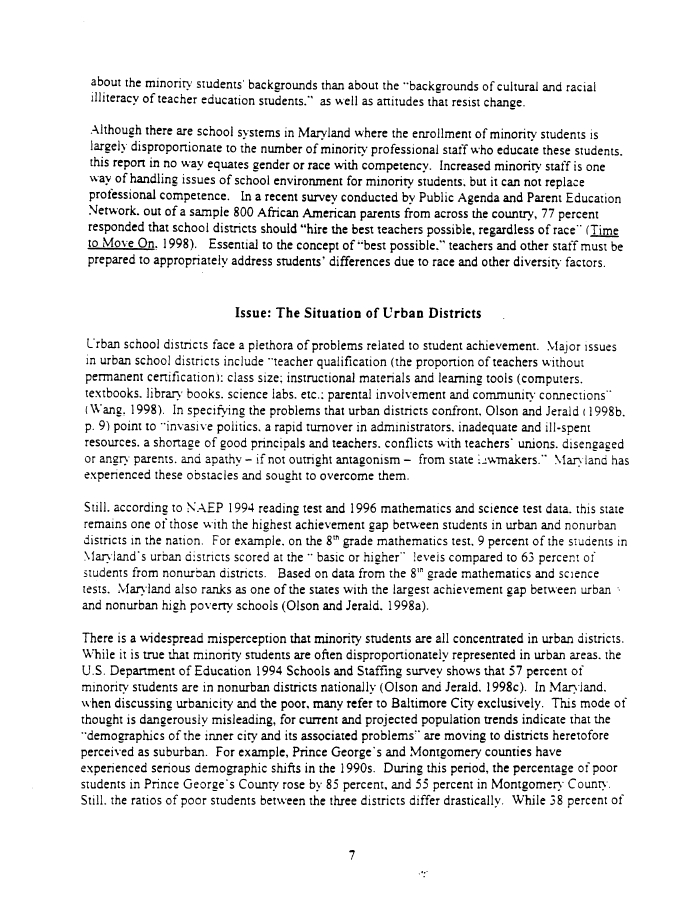 |
||||
|
TASK FORCE TO STUDY THE HISTORY AND LEGACY OF SLAVERY IN MARYLAND (Final Report) 1999/12/31 MdHR 991422 MdHR 991422, Image No: 186 Print image (91K) |
 |
||||
|
TASK FORCE TO STUDY THE HISTORY AND LEGACY OF SLAVERY IN MARYLAND (Final Report) 1999/12/31 MdHR 991422 MdHR 991422, Image No: 186 Print image (91K) |
| about the minority students' backgrounds than about the "backgrounds of cultural and racial illiteracy of teacher education students." as well as attitudes thai resist change. Although there are school systems in Maryland where the enrollment of minority students is largely disproportionate to the number of minoriry professional staff who educate these students, this report in no way equates gender or race with competency. Increased minority staff is one way of handling issues of school environment for minoriry students, but it can not replace professional competence. In a recent survey conducted by Public Agenda and Parent Education Network, out of a sample 800 African American parents from across the country, 77 percent responded that school districts should "hire the best teachers possible, regardless of race" (Time to Move On. 1998). Essential to the concept of "best possible." teachers and other staff must be prepared to appropriately address students' differences due to race and other diversity factors. Issue: The Situation of Urban Districts Urban school districts face a plethora of problems related to student achievement. Major issues in urban school districts include "teacher qualification (the proportion of teachers without permanent certification): class size; instructional materials and learning tools (computers, lextbooks. library books, science labs, etc.: parental involvement and community connections" (\Vang? 1998). In specifying the problems that urban districts confront. Olson and Jerald (1998b. p. 9) point to "invasive politics, a rapid turnover in administrators, inadequate and ill-spent resources, a shortage of good pnncipals and teachers, conflicts with teachers' unions, disengaged or angry parents, and apathy - if not outright antagonism - from state --ivvmakers." Maryland has experienced these obstacles and sought to overcome them. Still, according to N'AEP 1994 reading test and 1996 mathematics and science test data, this staie remains one of those with the highest achievement gap between students in urban and nonurban districts in the nation. For example, on the 8tn grade mathematics test. 9 percent of the students in Man-land's urban districts scored at the " basic or higher" levels compared to 63 percent of students from nonurban districts. Based on data from the 8in grade mathematics and science tests. Man-land also ranks as one of the states with the largest achievement gap between urban •-and nonurban high poverty schools (Olson and Jerald. 1998a). There is a widespread misperception that minoriry students are all concentrated in urban districts. While it is true that minoriry students are often disproportionately represented in urban areas, the U.S. Department of Education 1994 Schools and Staffing survey shows that 57 percent of minoriry students are in nonurban districts nationally (Olson and Jeraid, 1998c). In Man-land, when discussing urbaniciry and the poor, many refer to Baltimore City exclusively. This mode of thought is dangerously misleading, for current and projected population trends indicate ihat the "demographics of the inner city and its associated problems" are moving to districts heretofore perceived as suburban. For example, Prince George's and Montgomery counties have experienced serious demographic shifts in the 1990s. During this period, the percentage of poor smdents in Prince George's County rose by 85 percent, and 55 percent in Montgomery County. Still, the ratios of poor students between the three districts differ drastically. While 38 percent of |